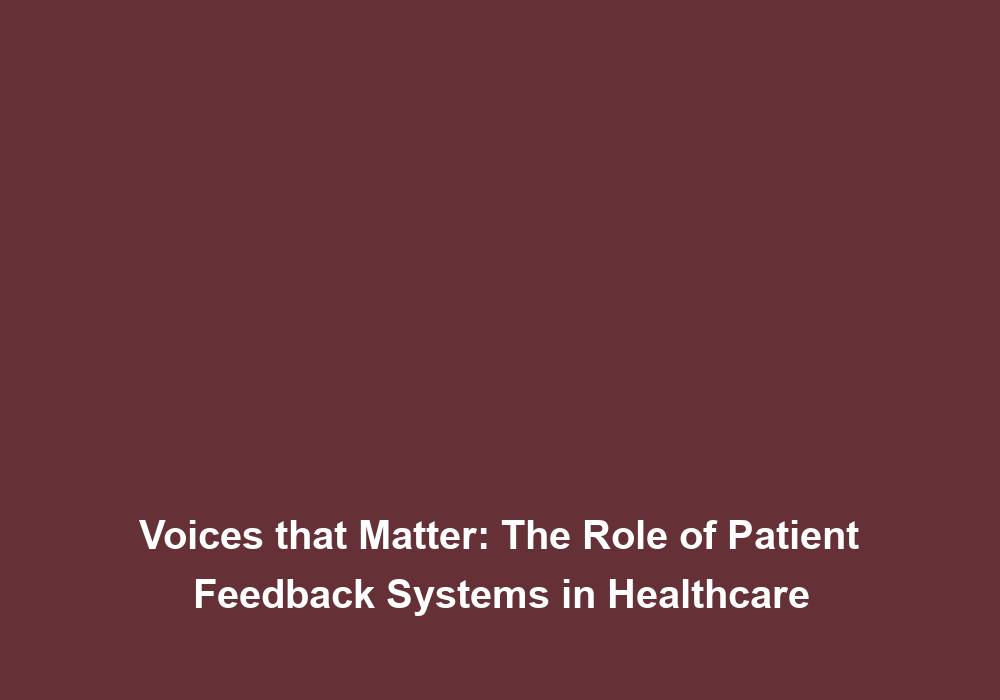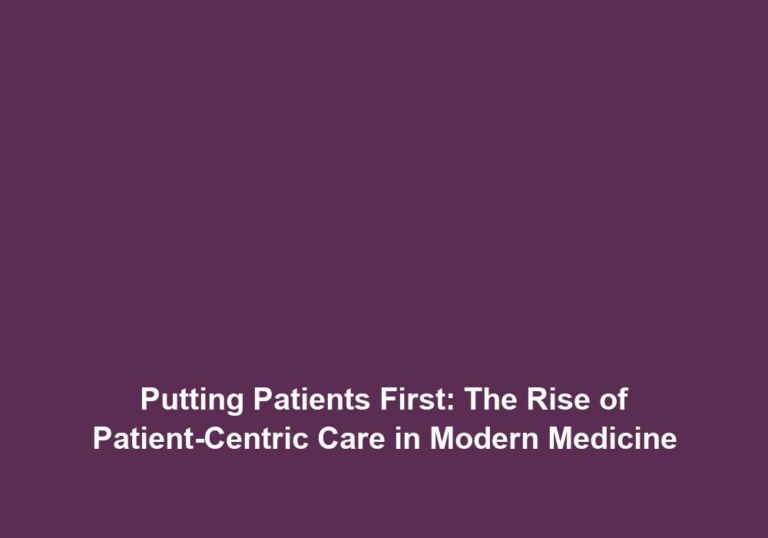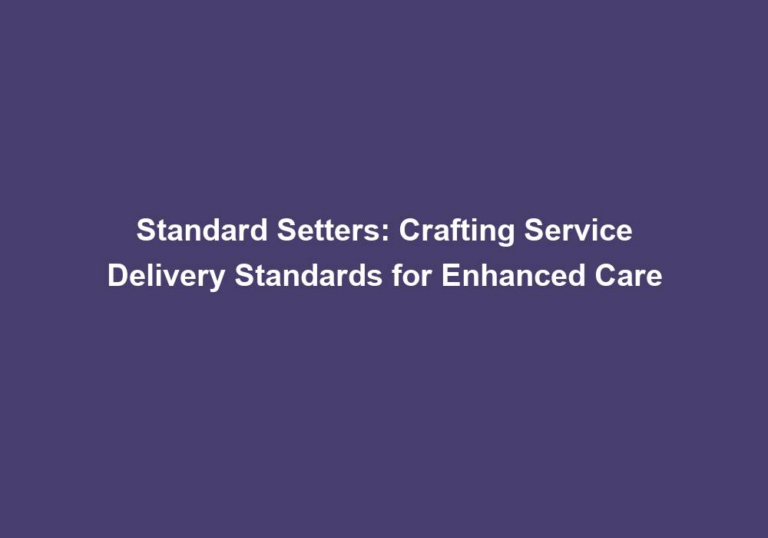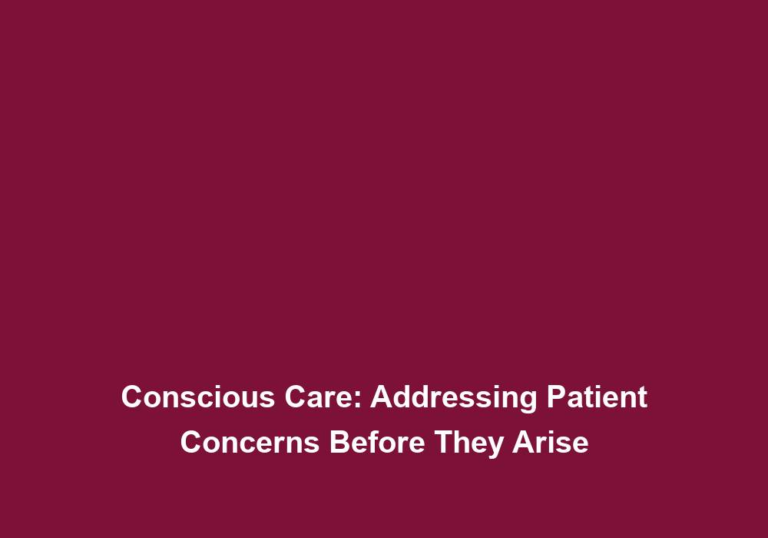Voices that Matter: The Role of Patient Feedback Systems in Healthcare
In the ever-evolving landscape of healthcare, the voices of patients play a crucial role in shaping the quality of care and services provided. Patient feedback systems have emerged as powerful tools to capture and utilize patient experiences and opinions, ultimately leading to improved healthcare outcomes. This article explores the significance of patient feedback systems in healthcare and highlights their role in enhancing patient-centered care.
Understanding Patient Feedback Systems
Patient feedback systems encompass various methods and techniques used to collect and analyze feedback from patients. These systems can range from simple surveys and comment cards to sophisticated online platforms and mobile applications. The primary objective of patient feedback systems is to gather comprehensive and actionable insights directly from patients, enabling healthcare providers to identify areas for improvement and make informed decisions.
Patient feedback systems have evolved significantly over the years, leveraging advancements in technology to provide more efficient and accessible ways for patients to share their experiences. Online portals and mobile applications have made it easier for patients to provide feedback at their convenience, eliminating the need for traditional paper-based methods. These digital platforms also allow for real-time data collection, enabling healthcare organizations to capture feedback at various touchpoints throughout a patient’s healthcare journey.
Additionally, patient feedback systems can utilize various data collection techniques, such as surveys, interviews, and focus groups, to gather qualitative and quantitative data. This comprehensive approach ensures that healthcare providers obtain a holistic understanding of patient experiences and opinions, enabling them to identify both strengths and areas for improvement.
The Power of Patient Voices
-
Improving Service Quality: Patient feedback serves as a valuable source of information for healthcare providers to identify strengths and weaknesses in their services. By actively listening to patient voices, healthcare organizations can identify areas that require improvement and implement changes accordingly. For example, if multiple patients provide feedback about long wait times in the emergency department, the healthcare organization can allocate resources to address this issue, ultimately leading to enhanced service quality and patient satisfaction.
-
Identifying Systemic Issues: Patient feedback systems help identify systemic issues that may otherwise go unnoticed. By analyzing patterns and trends in patient feedback, healthcare providers can identify recurring issues and address them effectively. For instance, if multiple patients express concerns about the cleanliness of a specific hospital ward, the healthcare organization can implement stricter protocols for infection control, ensuring a safer environment for all patients. This systematic approach enables organizations to enhance overall care delivery and patient experience.
-
Driving Patient-Centered Care: Patient feedback systems play a crucial role in promoting patient-centered care. By actively seeking patient input, healthcare providers can tailor their services to meet individual patient needs and preferences. For example, if patients consistently express a preference for more personalized communication from their healthcare providers, the organization can implement initiatives such as patient portals or telehealth services to facilitate better communication. This fosters a collaborative and patient-centric approach, ultimately leading to improved health outcomes and patient satisfaction.
-
Enhancing Patient Safety: Patient feedback systems contribute to enhancing patient safety by identifying potential risks and issues. Patients are often the first to notice safety concerns or lapses in care. By having mechanisms in place to capture and address patient feedback, healthcare providers can proactively identify and resolve safety issues, minimizing risks and improving patient safety. For instance, if patients report medication errors or near-miss incidents, the organization can implement additional safety checks or training programs to prevent future occurrences.
Patient feedback systems are not only beneficial for healthcare providers but also empower patients to actively participate in their own healthcare journey. By providing feedback, patients feel heard and valued, fostering a sense of trust and engagement with the healthcare organization.
Implementing Effective Patient Feedback Systems
To harness the full potential of patient feedback systems, healthcare organizations must ensure their implementation is effective and efficient. Here are some key considerations for implementing an effective patient feedback system:
1. Accessibility and Ease of Use
Patient feedback systems should be easily accessible to patients and user-friendly. Whether it is through online portals, mobile applications, or traditional paper-based methods, the system should be designed to accommodate a wide range of patients and their varying technological literacy levels. User interfaces should be intuitive, and clear instructions should be provided to guide patients through the feedback process.
Additionally, healthcare organizations should consider providing multiple channels for feedback submission to cater to different patient preferences. This could include options such as email, phone calls, or even in-person feedback sessions.
2. Anonymity and Confidentiality
Patients need to feel comfortable providing honest feedback. Implementing measures to ensure anonymity and confidentiality can encourage patients to share their experiences openly. This can be achieved by using secure and confidential methods of data collection and storage.
Healthcare organizations should clearly communicate to patients how their feedback will be handled and assure them that their identity will be protected. Anonymizing the data collected and storing it securely in compliance with privacy regulations can help build trust and encourage more patients to provide feedback.
3. Timely Feedback Collection
Collecting feedback in a timely manner is crucial to capture accurate patient experiences. Healthcare organizations should establish processes to collect feedback at various touchpoints, ensuring patients can provide input at different stages of their healthcare journey.
For example, feedback can be collected after a hospital stay, outpatient appointment, or even through post-visit surveys. By capturing feedback at different stages, healthcare organizations gain a comprehensive understanding of the patient journey and can identify areas for improvement more effectively.
4. Data Analysis and Actionable Insights
Collecting feedback is just the first step; healthcare providers must have mechanisms in place to analyze and interpret the data collected. This analysis should generate actionable insights that can be used to drive improvements in service quality, patient safety, and overall patient experience.
Healthcare organizations can leverage data analytics tools and techniques to identify trends, patterns, and correlations within the feedback data. These insights can then be used to prioritize areas for improvement and guide decision-making processes. For example, if a significant number of patients provide feedback about the lack of clear communication from healthcare providers, the organization can implement communication training programs to address this issue.
5. Communication and Transparency
Healthcare organizations should communicate with patients about the actions taken based on their feedback. This fosters transparency and demonstrates that patient voices are valued and have a direct impact on the care provided. Regular updates can also help in building trust and maintaining patient engagement.
By sharing the changes or improvements made based on patient feedback, healthcare organizations show patients that their opinions matter and contribute to the overall improvement of healthcare services. This communication can be done through various channels, such as newsletters, patient portals, or even public forums.
Conclusion
Patient feedback systems have emerged as a vital component of healthcare, providing a platform for patients to express their opinions and experiences. By actively listening to patient voices and leveraging feedback, healthcare organizations can continuously improve service quality, enhance patient safety, and deliver patient-centered care. Implementing effective patient feedback systems ensures that the voices of patients truly matter and contribute to the overall improvement of healthcare services.
Please note that the complete article is shown in markdown format.







